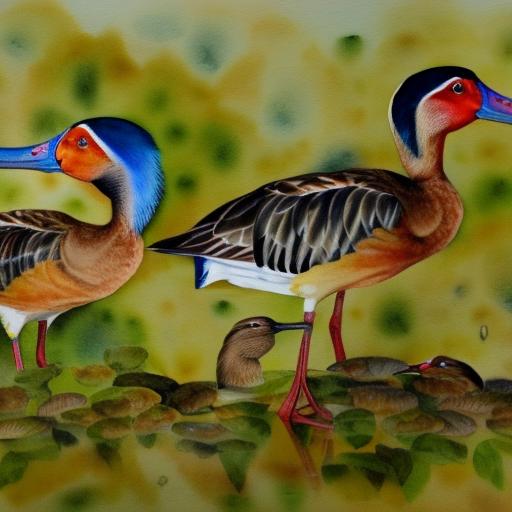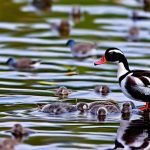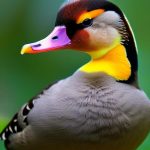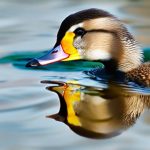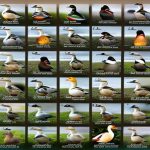The Black-Bellied Whistling Duck, also known as the Black-Bellied Tree Duck, is a unique species of waterfowl that is native to the southern United States, Central and South America. These ducks are easily recognizable by their striking appearance, with a long neck, bright pink bill, and distinctive black belly. They are medium-sized ducks, with a wingspan of around 30 inches and a body length of 18-20 inches. Their plumage is predominantly chestnut brown, with black and white markings on their wings and a bright red eye. The Black-Bellied Whistling Duck gets its name from the distinctive whistling sound it makes, which is often heard during flight or when they are disturbed.
These ducks are highly social and are often found in large flocks, particularly during the breeding season. They are primarily found in wetland habitats such as marshes, ponds, and lakes, where they feed on a diet of aquatic plants, seeds, and insects. Black-Bellied Whistling Ducks are known for their strong flying abilities and can often be seen flying in V-shaped formations. They are also known for their distinctive courtship displays, which involve elaborate rituals and vocalizations. These ducks are a popular sight for birdwatchers and nature enthusiasts, and their unique appearance and behavior make them a fascinating subject for study.
Key Takeaways
- Black-Bellied Whistling Ducks are unique waterfowl known for their distinctive whistling calls and striking appearance.
- The breeding season for Black-Bellied Whistling Ducks typically occurs during the spring and summer months.
- These ducks prefer to nest in tree cavities or nest boxes near water, and they are known to form large colonies for nesting.
- Courtship and mating rituals of Black-Bellied Whistling Ducks involve elaborate displays and vocalizations to attract a mate.
- Female ducks lay a clutch of 9-16 eggs and are responsible for incubating them for about a month before hatching.
The Breeding Season of Black-Bellied Whistling Ducks
The breeding season for Black-Bellied Whistling Ducks typically begins in late spring and extends through the summer months. During this time, the ducks engage in elaborate courtship displays and rituals to attract a mate. These displays often involve the males performing intricate dances and vocalizations to impress the females. The ducks are highly social during this time, and large flocks can often be seen gathering in wetland habitats to engage in these courtship behaviors.
Once a pair has formed, they will begin to search for a suitable nesting site. Black-Bellied Whistling Ducks are known for their adaptability when it comes to nesting, and they will often choose a site near water that provides ample cover and protection from predators. The female will then begin to construct the nest using grasses, reeds, and other plant materials, creating a shallow depression in the ground lined with down feathers. The male will often stand guard nearby, keeping a watchful eye out for any potential threats to the nest.
Nesting Behavior and Habitat
Black-Bellied Whistling Ducks are known for their unique nesting behavior and habitat preferences. These ducks are highly adaptable when it comes to nesting, and they will often choose a variety of different sites depending on the availability of suitable habitat. They are commonly found nesting in wetland areas such as marshes, ponds, and lakes, where they can find ample food and protection from predators.
The female will typically construct the nest using grasses, reeds, and other plant materials, creating a shallow depression in the ground lined with down feathers. The male will often stand guard nearby, keeping a watchful eye out for any potential threats to the nest. Once the nest is complete, the female will lay a clutch of around 10-16 eggs, which she will then incubate for around 25-30 days. During this time, the male will continue to stand guard and protect the nesting female from any potential threats.
Courtship and Mating Rituals
Black-Bellied Whistling Ducks are known for their elaborate courtship and mating rituals, which are often characterized by intricate displays of dancing and vocalizations. During the breeding season, the males will perform elaborate dances to attract a mate, often flapping their wings and bobbing their heads in an effort to impress the females. These displays are often accompanied by loud whistling calls, which can be heard from a distance.
Once a pair has formed, they will engage in mutual preening and other bonding behaviors to strengthen their bond. The male will often follow the female closely, keeping a watchful eye out for any potential rivals. These courtship rituals are an important part of the breeding process for Black-Bellied Whistling Ducks and play a crucial role in pair bonding and mate selection.
Egg Laying and Incubation
After the courtship rituals have taken place and a pair has formed, the female Black-Bellied Whistling Duck will begin to lay her eggs. The female will typically lay a clutch of around 10-16 eggs, which she will then incubate for around 25-30 days. During this time, the male will continue to stand guard and protect the nesting female from any potential threats.
The eggs are a pale cream color and are laid at intervals of around one day apart. Once all the eggs have been laid, the female will begin to incubate them, keeping them warm and protected from the elements. Incubation is a crucial time for the female duck, as she must remain dedicated to keeping the eggs warm and safe until they are ready to hatch.
Hatching and Rearing of Ducklings

After around 25-30 days of incubation, the eggs of the Black-Bellied Whistling Ducks will begin to hatch. The ducklings are precocial, meaning that they are born with their eyes open and are able to leave the nest shortly after hatching. The female will lead her brood to water shortly after hatching, where the ducklings will begin to feed on insects and small aquatic plants.
The ducklings will remain under the care of their mother for several weeks as they grow and develop. During this time, the female will teach her young how to forage for food and protect them from potential predators. The male may also play a role in protecting the brood and teaching them important survival skills.
Conservation Efforts for Black-Bellied Whistling Ducks
Black-Bellied Whistling Ducks face a number of threats in the wild, including habitat loss, hunting, and predation. As a result, conservation efforts have been put in place to help protect these unique waterfowl. Wetland conservation programs have been established to help preserve important habitat for these ducks, while hunting regulations have been put in place to ensure that populations remain stable.
In addition to these efforts, research is ongoing to better understand the behavior and ecology of Black-Bellied Whistling Ducks so that more targeted conservation strategies can be developed. By studying their nesting behavior, courtship rituals, and habitat preferences, researchers can gain valuable insights into how best to protect these ducks in the wild.
Overall, Black-Bellied Whistling Ducks are a fascinating species of waterfowl that play an important role in their native ecosystems. Their unique appearance, social behavior, and elaborate courtship rituals make them a popular subject for birdwatchers and nature enthusiasts alike. By understanding more about their breeding habits and conservation needs, we can work towards ensuring that these ducks continue to thrive in the wild for generations to come.
During the black-bellied whistling duck breeding season, it’s essential to provide a suitable environment for nesting and breeding. If you’re looking for tips on creating the perfect nesting space, check out this informative article on converting a shed to a chicken coop. It offers valuable insights that can be adapted to accommodate the needs of these beautiful ducks during their breeding season.
FAQs
What is the breeding season for black-bellied whistling ducks?
The breeding season for black-bellied whistling ducks typically occurs from April to July, with peak breeding activity in May and June.
Where do black-bellied whistling ducks typically breed?
Black-bellied whistling ducks breed in a variety of wetland habitats, including marshes, ponds, and shallow lakes in the southern United States, Mexico, Central America, and parts of South America.
How do black-bellied whistling ducks build their nests?
Black-bellied whistling ducks build their nests in tree cavities, hollow logs, or dense vegetation near water. They line their nests with down feathers and other soft materials.
How many eggs do black-bellied whistling ducks typically lay?
Black-bellied whistling ducks typically lay 9-16 eggs in a single clutch.
How long does it take for black-bellied whistling duck eggs to hatch?
Black-bellied whistling duck eggs take about 25-30 days to hatch after they are laid.
Do black-bellied whistling ducks mate for life?
Black-bellied whistling ducks are monogamous and often form long-term pair bonds, but they do not necessarily mate for life. They may choose new mates in subsequent breeding seasons.
How do black-bellied whistling ducks care for their young?
Both male and female black-bellied whistling ducks participate in caring for their young. They lead their ducklings to water shortly after hatching and provide protection and guidance as the ducklings grow.
Meet Walter, the feathered-friend fanatic of Florida! Nestled in the sunshine state, Walter struts through life with his feathered companions, clucking his way to happiness. With a coop that’s fancier than a five-star hotel, he’s the Don Juan of the chicken world. When he’s not teaching his hens to do the cha-cha, you’ll find him in a heated debate with his prized rooster, Sir Clucks-a-Lot. Walter’s poultry passion is no yolk; he’s the sunny-side-up guy you never knew you needed in your flock of friends!

